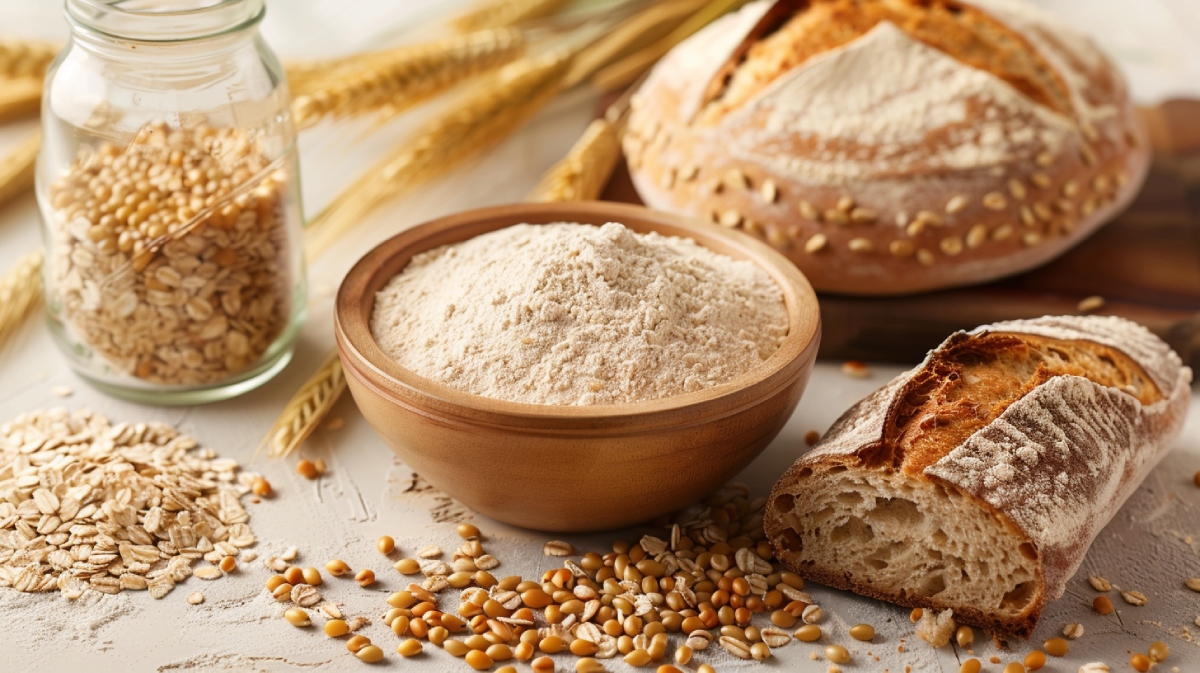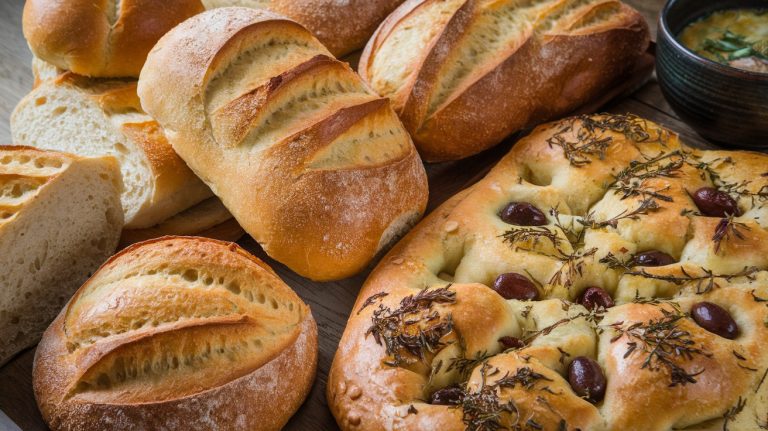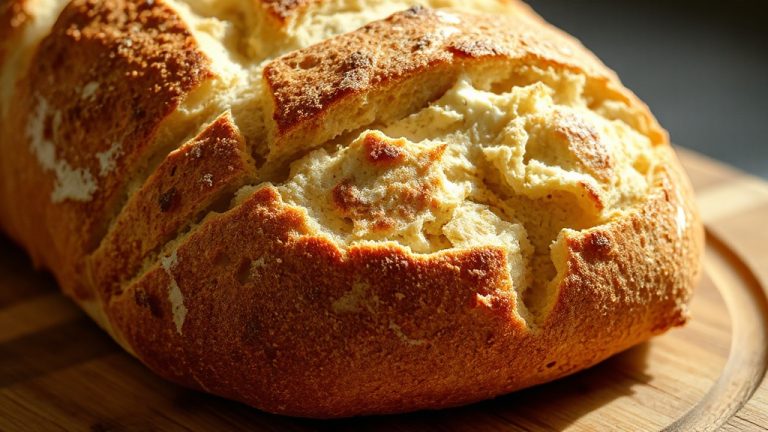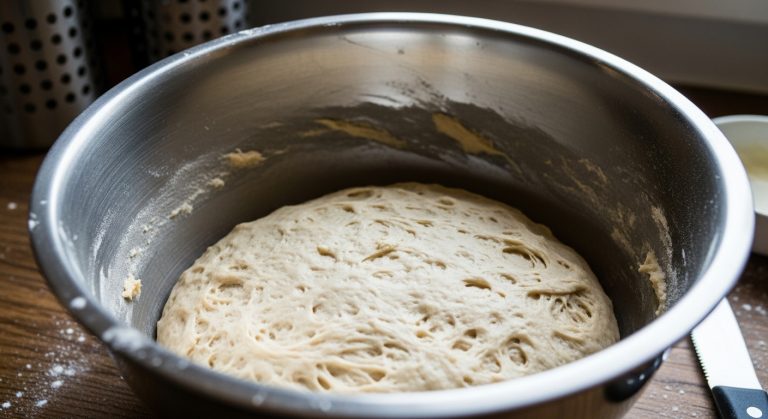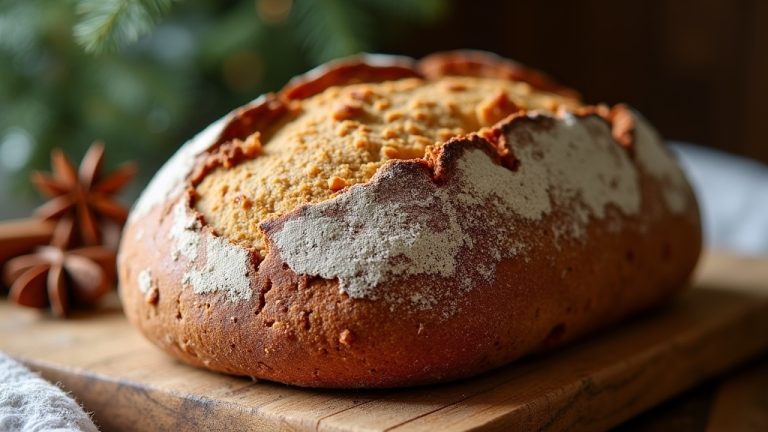How to Make Spelt Sourdough Bread: Step Up Your Baking Game
Mix 500g of whole-grain spelt flour with 350-375g of water to make spelled sourdough bread. Allow the dough to rest for about an hour, then knead until smooth.
Let it rise for around 4.5 hours, performing stretch and folds every half hour. After shaping, proof in the fridge for 12-14 hours.
Preheat your Dutch oven to 475°F, score the dough, and bake it covered for 25 minutes, then uncover it for another 20 minutes until golden. The process infuses deep flavors and nutrients; keep exploring to master each step for the perfect loaf.
Key Takeaways
- Use 500g of whole grain spelt flour, 8g of salt, and 50g of active sourdough starter, adjusting water between 350g to 375g.
- Mix flour and water, let the dough rest for 30-60 minutes during the autolyse phase for better gluten development.
- Perform bulk fermentation for 4.5 hours, with four sets of stretch and folds every 30 minutes, aiming for a 30-50% volume increase.
- Shape the dough into boules and proof in the refrigerator for 12-14 hours to enhance flavor and texture.
Baking Schedule Overview
Spelt, an ancient grain known scientifically as Triticum spelta, offers a nutty flavor and a higher nutritional profile than modern wheat, making it an intriguing choice for those seeking a wholesome alternative in their baking. To create the perfect spelt sourdough, timing’s everything.
You’ll want to master the key fermentation phases, ensuring each step builds flavor and strength in your dough.
Plus, don’t underestimate the benefits of overnight proofing; it’s your secret weapon for achieving that rich, complex taste.
Ideal Timing for Baking
For a successful spelt sourdough bread, timing guides you through each critical step, from feeding your starter to the final bake. Here’s a baking schedule to follow:
- 9 AM: Feed your sourdough starter to guarantee peak activity.
- 2 PM: Combine spelt flour, water, and salt, then let it autolyse for 1 hour to hydrate the flour.
- 3 PM: Knead the dough and perform four sets of stretch and folds every 30 minutes during bulk fermentation.
- Evening: Shape the dough and refrigerate it for a final proof of 12-14 hours.
This careful timing enhances flavor and texture, guaranteeing a beautiful oven spring and a delightful whole grain loaf that you’ll be proud to serve.
Key Fermentation Phases
The key fermentation phases in making spelt sourdough bread are essential for developing a rich flavor and a perfect texture, guiding you through the transformation of simple ingredients into a delightful loaf.
Start by feeding your sourdough starter at 9 AM, ensuring it’s ready for mixing your dough at 2 PM.
After mixing, let the dough rest for an hour during the autolyse phase, enhancing hydration and gluten development.
During bulk fermentation, perform four sets of stretch and folds until the dough rises about 75%.
Shape the dough in the evening and refrigerate for a cold proof of 12-15 hours.
Overnight Proofing Benefits
Overnight proofing transforms your spelt sourdough into a flavor-packed masterpiece, maximizing aroma and texture while fitting seamlessly into your baking schedule. This method enhances flavor development and improves dough structure for a delightful open crumb.
Here are the key benefits:
- Enhanced Flavor Development: Slow fermentation allows complex flavors and aromas to blossom.
- Improved Dough Structure: The cold environment promotes better rise and texture in your loaf.
- FODMAP Reduction: Longer fermentation can lower FODMAP levels, making your bread easier to digest.
- Controlled Yeast Activity: Cooler temperatures prevent overproofing, ensuring consistent dough volume and texture.
With overnight proofing, you’ll create stunning sourdough while maintaining a manageable baking schedule.
Ingredients Needed
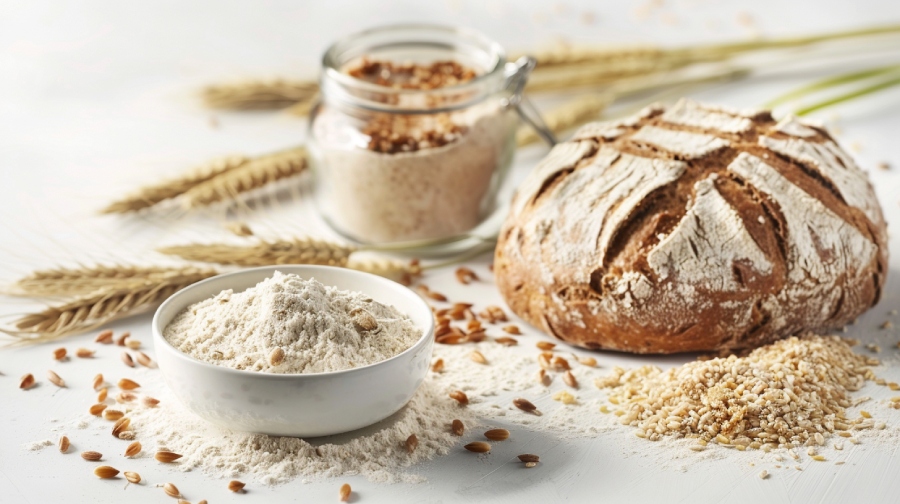
To create a delicious spelt sourdough bread, you’ll gather high-quality ingredients that elevate the flavor and texture of your loaf.
Start with 500g of whole grain spelt flour, ideally freshly milled for best taste and nutrition.
Next, incorporate 8g of fine sea salt, which enhances the overall flavor profile.
You’ll also need 50g of an active sourdough starter, whether it’s whole wheat or spelt-fed, to kickstart fermentation.
Water is essential too; adjust it between 350g to 375g, depending on the moisture level of your flour, ensuring proper hydration.
Mixing and Autolyse Process
Start by mixing the whole grain spelt flour and water in a large bowl, ensuring every grain of flour is fully incorporated to create a smooth, uniform mixture. This is essential for the autolyse phase, where you’ll let the dough rest for 30-60 minutes to hydrate the flour and promote gluten development.
After resting, gently knead the dough until it feels cohesive.
Sprinkle salt over the dough, using a small amount of reserved water to dissolve it evenly.
Monitor the dough’s consistency, adjusting water content if necessary, typically using 350-375g of water.
Bulk Fermentation Techniques
Bulk fermentation is an essential phase in making spelt sourdough bread, as it allows the dough to rise and develop flavor and texture through careful monitoring and methodical handling.
Typically lasting 4.5 hours at 78°F (25°C), you should aim for a volume increase of 30% to 50%. Perform four sets of stretch and folds every 30 minutes to enhance gluten strength and structure.
Watch for a slight dome at the edges and the formation of small bubbles, indicators that fermentation is progressing well. Keep a close eye on dough appearance to prevent over-proofing, ensuring it feels alive and jiggles slightly when handled.
Mastering these fermentation techniques is key to achieving that perfect rise in your spelt sourdough.
Shaping and Proofing the Dough
After the bulk fermentation has worked its magic, it’s time to shape the dough into beautiful boules that will rise with grace and flavor.
Follow these steps for perfect shaping and proofing:
- Divide the dough into two equal pieces and let each rest uncovered for 20 minutes to relax the gluten.
- Lightly flour your work surface and shape each round into a boule, maintaining good tension on the surface.
- Place each boule seam-side-up in a lightly dusted linen-lined banneton, then cover tightly with plastic wrap to prevent drying.
- For ideal flavor, retard the dough in the refrigerator at 38°F for 14 hours, allowing it to increase in size by 30-50% before baking.
Baking the Sourdough
Now that your boules have proofed beautifully, it’s time to bring them to life in the oven, where the magic of baking transforms your dough into a crusty, aromatic masterpiece.
Preheat your Dutch oven to 475°F (245°C) for at least 30 minutes to guarantee ideal steam retention.
Just before transferring your spelt sourdough, score the top with a sharp blade to allow for controlled expansion.
Bake covered for the first 25 minutes to trap steam, then uncover and continue baking for another 20 minutes until you achieve that golden-brown crust.
Once done, place your fresh bread on a cooling rack for at least an hour to set the crumb structure and enhance flavor.
Storage Tips for Freshness
To keep your spelt sourdough bread fresh and flavorful, you’ll want to choose the right storage method that preserves its unique texture and taste. Here are some tips to guarantee your loaf stays delicious:
- Store uncut bread in a paper or linen bag to allow for airflow, maintaining that perfect crust.
- For cut bread, place it cut side down on a cutting board or plate to retain moisture and prevent staling.
- Avoid plastic bags; they trap moisture, leading to a soft crust and quicker spoilage.
- If freezing, wrap your bread tightly in aluminum foil or freezer-safe plastic wrap, then thaw at room temperature. Revive it in a preheated oven for a few minutes to restore its crustiness and maximize freshness.
Health Benefits of Spelt Sourdough
When you choose spelt sourdough, you’re not just enjoying a delicious loaf; you’re also reaping a wealth of nutritional advantages.
Packed with B vitamins, fiber, and essential fatty acids, this bread supports your overall health while tantalizing your taste buds.
Plus, its unique fermentation process makes it gentler on your digestive system, offering a satisfying option for those with mild gluten sensitivities.
Nutritional Advantages of Spelt
Packed with nutrients, spelt sourdough bread offers a heart-healthy option that not only delights the palate but also nourishes your body with essential vitamins and minerals. By choosing spelt sourdough, you’re tapping into a variety of benefits:
- Whole Grain Goodness: Retaining bran and germ, it’s rich in B vitamins and fiber.
- Digestive Benefits: With about 4g of fiber per serving, it promotes satiety.
- Lower Gluten Content: Spelt flour’s lower gluten level may be easier for some to digest.
- Mineral Rich: Packed with essential minerals like iron and magnesium, important for bodily functions.
Moreover, the fermentation process enhances nutrient bioavailability, allowing for better absorption of these crucial nutrients.
Digestive Health Benefits
Enjoying spelt sourdough bread can greatly enhance your digestive health, thanks to its unique combination of lower gluten content and beneficial fermentation process.
This bread is particularly suitable for those with mild gluten sensitivities, as its lower gluten levels make it easier to digest.
The fermentation also reduces FODMAP levels, making it a great option for those with irritable bowel syndrome.
Whole grain spelt flour is rich in dietary fiber, promoting regular bowel movements and overall gut health.
Additionally, spelt contains prebiotic fibers that nourish beneficial gut bacteria, supporting a healthy microbiome.
With all these qualities, spelt sourdough bread not only delights your taste buds but also boosts nutrient absorption, making it an essential part of your diet.
Frequently Asked Questions
Is Spelt Good for Making Sourdough?
You might worry spelt’s lower gluten affects your bread’s rise, but it actually creates a delightful nutty flavor and texture. When combined properly, spelt makes a nutritious, flavorful sourdough that’s easier to digest.
Can You Make Sourdough Starter From Spelt?
Yes, you can absolutely make a sourdough starter from spelt! By mixing equal parts whole grain spelt flour and water, you’ll create a vibrant, flavorful starter that enhances your baking with its unique nutty essence.
How Long Is Fermentation for Spelt Sourdough?
Picture your dough gently rising, a warm embrace of air bubbles forming within. You’ll find that bulk fermentation for spelt sourdough takes about 4.5 hours, with careful monitoring ensuring it doesn’t over-ferment and deflate.
Is Spelt Flour Good for Bread Making?
Yes, spelt flour’s unique flavor and higher protein content make it excellent for bread making. Its lower gluten levels create a denser loaf, but blending with other flours enhances the texture and rise beautifully.
Nourish Your Spirit: The Heartfelt Joy of Homemade Spelt Sourdough
Now that you’ve mastered the art of spelt sourdough, each loaf will rise like a phoenix, filling your kitchen with warmth and the scent of nostalgia.
With its nutty flavor and health benefits, your bread isn’t just food; it’s a celebration of nature’s bounty.
As you slice into the golden crust, remember to savor each bite.
Store your creations carefully, and let the joy of baking continue to nourish your spirit and those you love.
Happy baking!

